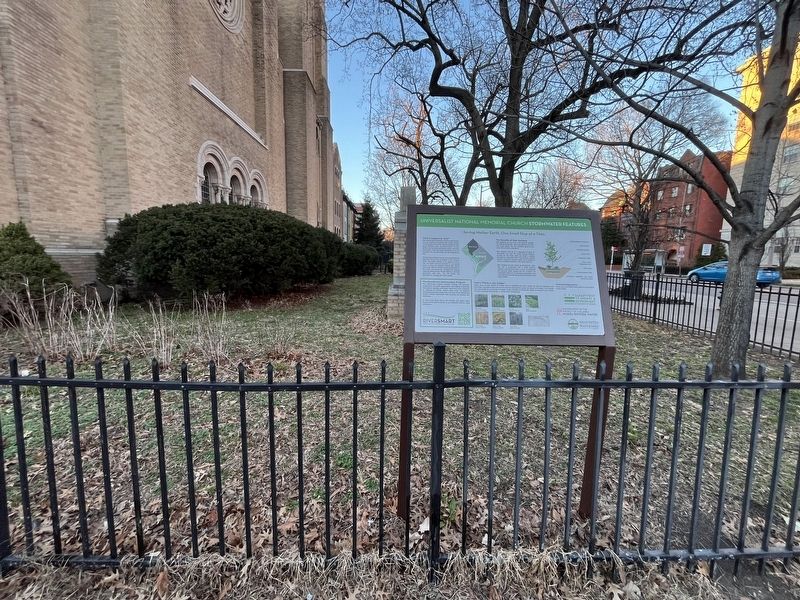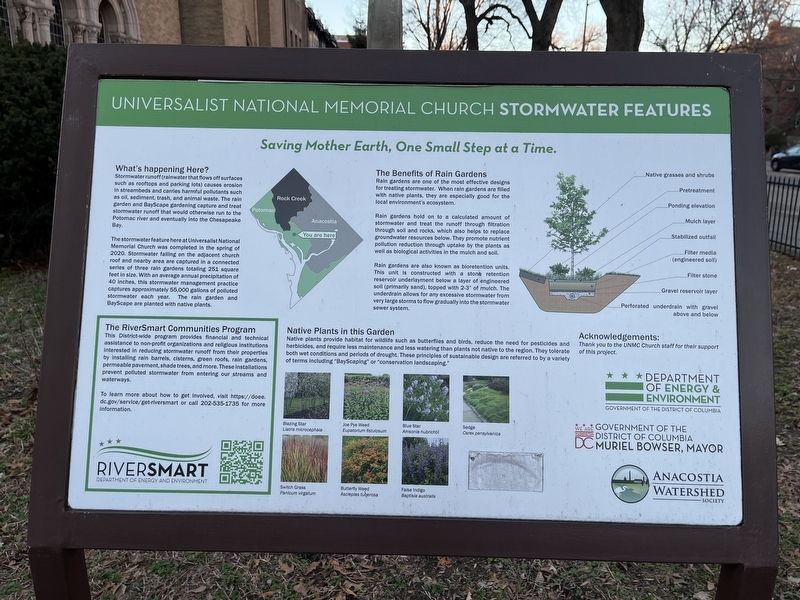Dupont Circle in Northwest Washington in Washington, District of Columbia — The American Northeast (Mid-Atlantic)
Universalist National Memorial Church Stormwater Features
Saving Mother Earth, One Small Step at a Time.
Inscription.
What's happening Here?
Stormwater runoff (rainwater that flows off surfaces such as rooftops and parking lots) causes erosion in streambeds and carries harmful pollutants such as oil, sediment, trash and animal waste. The rain garden and BayScape gardening are capturing and treating stormwater runoff that would otherwise run to Rock Creek, the Potomac river and eventually into the Chesapeake Bay.
The stormwater features here at Universalist National Memorial Church was completed in the spring of 2020. Stormwater falling on the adjacent church roof and nearby area are captured in a connected series of three rain gardens totaling 251 square feet in size. With an average annual precipitation 40 inches, this stormwater management practice captures approximately 55,000 gallons of polluted stormwater each ear. The rain garden and BayScape are planted with native plants.
The Benefits of Rain Gardens
Rain gardens are one of the most effective designs for treating stormwater. When rain gardens are filled with native plants, they are especially good for the local environment's ecosystem.
Rain gardens hold on to a calculated amount of stormwater and treat the runoff through filtration through soil and rocks, which also helped to replace groundwater resources below. They promote nutrients pollution reduction through uptake by the plants as well as biological activities in the mulch and soil.
Rain gardens are also known as bioretention units. This unit is constructed with a stone retention reservoir underlayment below a layer of engineered soil (primarily sand), topped with 2-3" of mulch. The underdrain allows for any excessive stormwater from very large storms to flow gradually onto the adjacent land.
Native Plants in this Garden
Native plants provide habitat for wildlife such as butterflies and birds, reduce the need for pesticides & herbicides, and require less maintenance and less watering than plants not native to the region. They tolerate both wet conditions and periods of drought. These principles of sustainable design are referred to by a variety of terms including "BayScaping" or "conservation landscaping."
Blazing Star Liatris microcephala • Joe Pye Weed Eupatorium fistulosum • Blue Star Amsonia hubrichtil • Sedge Carex pensylvanica • Switch Grass Panicum virgatum • Butterfly Weed Asclepias tuberosa • False Indigo Baptisia australis
Acknowledgements:
Thank you to the UNMC Church staff for their support of this project.
The RiverSmart Communities Program
This District-wide program provides financial

Photographed By Devry Becker Jones (CC0), February 3, 2024
2. Universalist National Memorial Church Stormwater Features Marker
To learn more about how to get involved, visit https://doee.dc.gov/service/riversmart or call 202-535-1735 for more information.
Erected by DC Department of Environment, Government of the District of Columbia, Mural Bowser, Mayor; Anacostia Watershed Society; Universalist National Memorial Church.
Topics and series. This historical marker is listed in these topic lists: Churches & Religion • Environment • Waterways & Vessels. In addition, it is included in the Unitarian Universalism (UUism) series list. A significant historical year for this entry is 2020.
Location. 38° 54.852′ N, 77° 2.204′ W. Marker is in Northwest Washington in Washington, District of Columbia. It is in Dupont Circle. Marker is at the intersection of S Street Northwest and 16th Street Northwest, on the right when traveling west on S Street Northwest. Touch for map. Marker is at or near this postal address: 1810 16th St NW, Washington DC 20009, United States of America. Touch for directions.
Other nearby markers. At least 8 other markers are within walking distance of this marker . Owen D Young Peace Tower (a few steps from this marker); Embassy of the Republic of Congo (within shouting distance of this marker); At 1740 New Hampshire Ave. (about 500 feet away, measured in a direct line); Todd Duncan Residence (about 500 feet away); Votes for Women (about 600 feet away); This section of 15th St. (about 600 feet away); The Whyland (about 600 feet away); Charlotte Forten Grimke House (about 600 feet away). Touch for a list and map of all markers in Northwest Washington.
Additional commentary.
1. About the marker
This sign serves as a historical marker because it demonstrates how this community has made a choice in addressing concerns of environmental stewardship. It shares at length how, why and when it worked on this project.
— Submitted February 3, 2024, by Devry Becker Jones of Washington, District of Columbia.
Credits. This page was last revised on February 4, 2024. It was originally submitted on February 3, 2024, by Devry Becker Jones of Washington, District of Columbia. This page has been viewed 45 times since then. Photos: 1, 2. submitted on February 3, 2024, by Devry Becker Jones of Washington, District of Columbia.
